From Lab to Clinic: Multidisciplinary Culture Puts Pitt Ahead of the Game
Translational medicine is an old idea with a new urgency and a new level of support, both of which stem from the realization that modern medicine is on the cusp of great things, but only if we can figure out how to translate good ideas from the lab to the clinic. Pitt has created a support structure and a culture that together demonstrate translational medicine is simply the way we do science.
Simply the Way We Do Science
At Pitt, discoveries in the lab get fast-tracked for the clinic.
Here, in a nutshell, is a fundamental challenge facing modern medicine: How can we best translate scientific discoveries made in the laboratory into cures, therapies, and guidelines for the treatment of patients in the clinic?
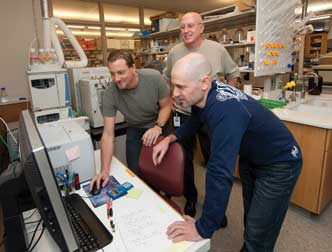 Bruce Freeman (middle, standing), the UPMC Irwin Fridovich Professor and chair of the Department of Pharmacology and Chemical Biology in Pitt’s School of Medicine, discovered nitro-fatty acid derivatives that may have applications as a drug to treat diabetes and metabolic and inflammatory diseases. He has launched a pharmaceutical startup company through the Pittsburgh Life Sciences Greenhouse to license the University patents and conduct human clinical trials. From left, Francisco Schopfer, a research assistant professor; Freeman; and Gustavo Bonacci, an instructor in the Department of Pharmacology and Chemical Biology.
Bruce Freeman (middle, standing), the UPMC Irwin Fridovich Professor and chair of the Department of Pharmacology and Chemical Biology in Pitt’s School of Medicine, discovered nitro-fatty acid derivatives that may have applications as a drug to treat diabetes and metabolic and inflammatory diseases. He has launched a pharmaceutical startup company through the Pittsburgh Life Sciences Greenhouse to license the University patents and conduct human clinical trials. From left, Francisco Schopfer, a research assistant professor; Freeman; and Gustavo Bonacci, an instructor in the Department of Pharmacology and Chemical Biology.Outside the medical and scientific fields, most people don’t think about this question. All we know is that the moment we become patients, we want results. We read the newspapers and we know that we are living in a golden age of scientific investigation. So we want our futuristic, life-changing medical care, and we want it now.
Except it’s not that easy. And that’s where translational medicine comes in. It’s an old idea. After all, the University of Pittsburgh has been conducting translational medicine throughout its history.
In one of the most dramatic and well-known examples, a Pitt professor named Jonas Salk, and a team of University researchers with Julius Youngner as senior scientist, developed a killed-virus polio vaccine in 1952. Based on years of laboratory research in virology, immunology, and cell culture techniques, the Pitt polio vaccine underwent nationwide clinical trials and was introduced to the general public in 1955, leading to a dramatic drop in the incidence of this previously unpreventable, devastating disease.
Youngner, Pitt Distinguished Service Professor Emeritus of Microbiology and Molecular Genetics, notes that the speed and scope of the clinical trial of the polio vaccine—involving 1.8 million children in 12 states—could never be replicated in today’s regulatory environment. One estimate suggests that it now takes 17 years on average to incorporate new research findings into widespread practice. Translational medicine is the art of improving public health by increasing the rate at which this happens and reducing the time it takes.
“The University has always been strong in translational medicine,” says Arthur S. Levine, senior vice chancellor for the health sciences and dean of the School of Medicine. “What is exciting now is that we have a very promising substrate of investigators working in the cutting-edge areas of science that are critical to the advancement of medicine in the 21st century. And we have them here in Pittsburgh, where we have thoughtfully and purposefully cultivated a culture of collaboration and interdisciplinary team science that is rarer in academia than one might think.”
Why Translational Medicine? Why Now?
In 2003, the National Institutes of Health released a landmark report—the NIH Roadmap—which laid out three themes for the future of biomedical research. The intention was to advance scientific understanding and to ensure that scientific discovery translates to better health. The three themes read like a how-to manual for translational medicine:
• Deepen our understanding of biology by investing heavily in basic sciences like structural biology, molecular biology, and computational biology;
• Stimulate interdisciplinary research teams so that scientists routinely move beyond the confines of their own disciplines and explore new organizational models for team science; and
• Accelerate medical discovery and bring those discoveries to bear on improving people’s health.
Pitt Prescience
When the NIH Roadmap was released, researchers and officials on campus might have thought the University of Pittsburgh had helped draft it. Pitt was already hard at work in these three thematic areas.
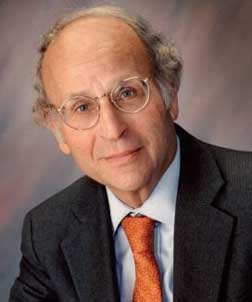 Arthur S. Levine
Arthur S. LevineBasic sciences research: Since the day he arrived in Pittsburgh in 1998 (after a long career at NIH, significantly), Levine has invested heavily in basic research in biomedical sciences. Building on immunological expertise already in place owing to strong programs in organ transplantation and infectious diseases research, the School of Medicine established the Department of Immunology in 2002. With a handful of high-profile recruits to complement the University’s existing expertise in molecular genetics, Levine jump-started a program in the fast-growing field of DNA repair. Soon after came new departments in structural biology, computational biology, developmental biology, and biomedical informatics.
Interdisciplinary research: Levine’s predecessor, the late Thomas Detre, said decades ago that the research programs that would really take off in the future would be multidisciplinary centers of excellence, where common problems would be approached collaboratively from many different perspectives. In later years, Detre would display an alphabetical list of 63 multidisciplinary centers started at Pitt under his tenure—from AIDS to genetics to tissue engineering—indicating his belief that these centers were key to Pitt’s rapid climb in the ranks of institutions receiving NIH research support. (Pitt entered NIH’s top 10 in 1997 and has been there ever since.)
Clinical Research: To better nurture translational medicine, the University created the Office of Clinical Research (OCR) in 2001. Operating across all six health sciences schools—medicine, public health, pharmacy, nursing, dental medicine, and health and rehabilitation sciences—OCR set out to help researchers collaborate across institutional and professional boundaries and to navigate the administrative complexities and nuances of the research process, allowing them to put their focus on research instead of red tape.
To facilitate the translation of discoveries to the real world, the University of Pittsburgh created the Office of Technology Management (OTM) in 1996. Led by Marc Malandro, associate vice chancellor for technology management, OTM addresses the fact that universities are very good at making discoveries and gathering evidence to answer scientific questions, but the details of commercialization are typically the purview of private industry. OTM ensures that the University interacts with industry to drive research and the translation of research results for the benefit of patients. One very significant stumbling block in this translation is the early stages of a new technology. Traditional NIH funding mechanisms only provide funding for the development of technology to a certain point.
From Discovery to Business Plan
The classic translational medicine story begins in a laboratory when a basic scientist looks up from the microscope or the latest experimental data and remarks, “Well, that’s odd.”
In 1990, one such scientist with a puzzled expression was biochemist Bruce Freeman. He was interested in free radicals—those highly reactive oxygen compounds that can wreak havoc on our cells. It had been shown in the lab that nitric oxide (NO) combined with free radicals spin off even more toxic, inflammatory byproducts. But that’s not what Freeman found in his experiments.
“When I tried to replicate those test-tube, chemistry-based observations in cell or animal models, we observed that nitric oxide, rather than being pro-inflammatory, had anti-inflammatory properties,” says Freeman, who is now the UPMC Irwin Fridovich Professor and chair of the Department of Pharmacology and Chemical Biology in Pitt’s School of Medicine.
And this wasn’t the only laboratory observation to make Freeman sit up and take notice. As he continued to investigate these surprising anti-inflammatory properties of NO, his experiments turned up a new and unusual molecule—a fatty acid with a nitrogen compound branching off from a carbon bond. He’d never seen nor heard of anything like it. These nitro-fatty acids, as they came to be called, are an important element of the anti-inflammatory properties of NO.
Since then, Freeman and many colleagues have painstakingly probed the biochemistry of these compounds. The picture that is emerging suggests they may be a safe, stable, easily produced drug with applications for diabetes and metabolic and inflammatory diseases. Freeman has launched a pharmaceutical start-up company through the Pittsburgh Life Sciences Greenhouse to license the University patents and conduct human clinical trials. Experimenting with several versions of nitro-fatty acids, the company has settled on a few that show evidence of being both powerful and safe. They are currently preparing to produce FDA-approved versions of the compounds for human trials.
An intriguing hint of the potential these compounds have for addressing health problems: In Nature Structural & Molecular Biology, Freeman and colleagues showed that their nitro-fatty acid fits a particular receptor in the cell membrane like a key in a lock. The same receptor is the target of the diabetes drug Avandia, but it had been previously unknown what naturally occurring compound might fit this receptor. Avandia’s annual global sales have totaled in the billions, but it has recently been associated with negative side effects, including heart attack.
Beyond Medicine
Translational medicine is not limited to the University’s six schools of the health sciences. Pitt’s School of Arts and Sciences houses numerous hot spots for translational biological and chemical research. Longstanding, productive collaborations with researchers in the health sciences help to ensure that research projects address the entire translational spectrum from laboratory to clinic and back again.
Jeffrey Brodsky, the Avinoff Professor of Biological Sciences, studies species of yeast, one of the most important organisms for laboratory research. Even those who are particularly fond of bread and fermented drinks probably do not think of yeast as a close relative. Many millions of years of evolution separate us from yeast. However, yeast species possess the same intracellular membrane organization as humans—and they are much easier to study in the lab than are human cells.
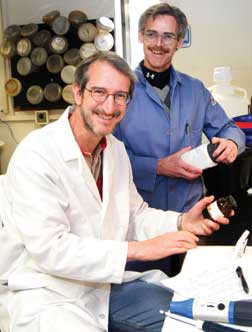 Jeffrey Brodsky, the Avinoff Professor of Biological Sciences (seated), and Peter Wipf, Distinguished University Professor in the Department of Chemistry, are collaborating on a project to search for potential therapeutic agents that inhibit the growth of cancer cells, thwart the replication of specific pathogens, and repair defects in cellular protein folding processes.
Jeffrey Brodsky, the Avinoff Professor of Biological Sciences (seated), and Peter Wipf, Distinguished University Professor in the Department of Chemistry, are collaborating on a project to search for potential therapeutic agents that inhibit the growth of cancer cells, thwart the replication of specific pathogens, and repair defects in cellular protein folding processes.Of particular interest to Brodsky and his collaborators, yeast and humans share a class of proteins known as “molecular chaperones,” which shepherd important biological proteins through the production process within cells. These chaperones also serve as quality-control managers, marking misfolded or otherwise defective proteins for destruction before they can lead to disease. (Cystic fibrosis, diabetes, and some heart, liver, and neurodegenerative diseases can all arise from defects in chaperone-mediated processes.)
Brodsky’s numerous publications and active projects include collaborators from Pitt’s Schools of Medicine, Pharmacy, Arts and Sciences, and more. With Peter Wipf, Distinguished University Professor, whose home base is the Department of Chemistry, Brodsky has developed a series of selective regulators of chaperone activity to search for candidate drugs that might fix defects in cellular protein-folding processes.
In some areas of public health research, the future is now—or, at least a few researchers are already using the tools of translational medicine to address public health concerns of the future. A 2010 paper in Nature Nanotechnology is the result of a collaborative effort by a slew of Pitt researchers plus colleagues from other institutions. It explores the biological mechanisms by which carbon nanotubes could be safely degraded before they become a danger to human health.
Carbon nanotubes, which are one-atom thick rolls of graphite 100,000 times smaller than a human hair yet stronger than steel, have a long list of industrial applications. They are used to reinforce plastics, ceramics, and concrete. They are excellent conductors of electricity and heat. But laboratory tests suggest that inhaling carbon nanotubes could result in severe lung inflammation and fibrosis.
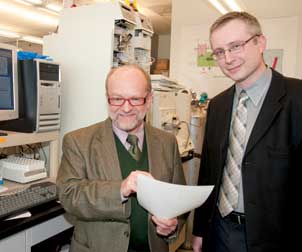 Valerian Kagan (left), a professor of environmental and occupational health in the Graduate School of Public Health, and Alexander Star, an assistant professor of chemistry, were part of a research study that showed how carbon nanotubes could be safely biodegraded by an enzyme of inflammatory cells in the body. These nanotubes are one-atom thick rolls of graphite 100,000 times smaller than a human hair yet stronger than steel—and they have many industrial uses. The recent study’s findings suggest that it might be possible to pack the nanotubes with drugs, using them as a biodegradable drug delivery system in humans.
Valerian Kagan (left), a professor of environmental and occupational health in the Graduate School of Public Health, and Alexander Star, an assistant professor of chemistry, were part of a research study that showed how carbon nanotubes could be safely biodegraded by an enzyme of inflammatory cells in the body. These nanotubes are one-atom thick rolls of graphite 100,000 times smaller than a human hair yet stronger than steel—and they have many industrial uses. The recent study’s findings suggest that it might be possible to pack the nanotubes with drugs, using them as a biodegradable drug delivery system in humans. Valerian Kagan, a professor of environmental and occupational health in the Graduate School of Public Health, has a long track record of research on nanotubes and health. For this nanotubes study, his collaborators include faculty from the Departments of Structural Biology and Cell Biology and Physiology in the School of Medicine. Another, Alexander Star, from the Department of Chemistry, received one of eight 2010 Outstanding New Scientist awards from the National Institute of Environmental Health Sciences. The Pitt researchers partnered with clinicians and basic scientists from as close as West Virginia and as far away as Ireland and Sweden to conduct this study, which revealed a new route by which carbon nanotubes could be enzymatically biodegraded in the body. Their findings can be used to develop methods for mitigating the inflammation caused by the inadvertent inhalation of nanotubes. Even more intriguing, the researchers raise the possibility that nanotubes can be safely biodegraded after inhalation, suggesting there could be a way to pack them with drugs and turn them into a biodegradable drug delivery system.
Clinical and Translational Science Institute
Independent confirmation of Pitt’s leadership position in translational medicine came in 2006, when NIH selected the University of Pittsburgh for inclusion in the first cohort of academic medical institutions to receive a Clinical and Translational Science Award (CTSA).
The CTSA program is an enormous initiative aimed at transforming the research and training environment in this country to enhance the efficiency and quality of clinical and translational research. It calls for a nationwide consortium of academic medical institutions eventually numbering 60. The first cohort included Pitt and 11 other institutions deemed advanced enough to set the standard. (In 2010, the CTSA consortium reached 55 member institutions.)
Totaling $83.5 million, the University of Pittsburgh’s CTSA immediately became the single-largest NIH award ever received by the University. (In 2010, the University submitted its first CTSA renewal application.) With the award, Pitt established a Clinical and Translational Science Institute (CTSI) to serve the dual purposes of integrating existing programs with innovative new clinical and translational science initiatives under a common umbrella and creating an awareness and understanding—initially among members of the biomedical research/ health care community, but eventually among the general public as well—of the tangible benefits to health practice that can be realized from clinical and translational research.
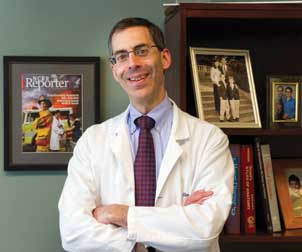 Steven Reis is director of Pitt’s Clinical and Translational Science Institute (CTSI), which integrates existing programs with innovative new clinical and translational science initiatives under a common umbrella. Almost all of CTSI’s pilot funding programs for research require investigators from different disciplines to work together. Reis is also a professor of medicine and associate vice chancellor for clinical research, health sciences.
Steven Reis is director of Pitt’s Clinical and Translational Science Institute (CTSI), which integrates existing programs with innovative new clinical and translational science initiatives under a common umbrella. Almost all of CTSI’s pilot funding programs for research require investigators from different disciplines to work together. Reis is also a professor of medicine and associate vice chancellor for clinical research, health sciences.“We want to change the culture. One way to do that is to change the way people approach science,” says Steven Reis, professor of medicine; associate vice chancellor for clinical research, health sciences; and CTSI director. “We want the basic science researchers to think about the clinical side of the equation and clinical researchers to consider mechanisms of basic science.”
“Dr. Reis has led a highly successful effort to establish clinical and translational science as a distinct discipline within and beyond our institution,” says Levine. “In the process, we have also trained a cadre of hundreds of multi- and interdisciplinary clinical and translational scientists.”
To provide Pitt researchers with support in important areas of expertise (red tape, for example), CTSI has developed nine resource cores. Among them are the following:
• The Regulatory Knowledge and Support Core provides education, training, services, and resources for researchers, health professionals, and even research participants from the community to promote good clinical practice and to facilitate regulatory compliance in clinical and translational research.
• The Translational Technologies and Resources Core promotes the use of a wide range of research core laboratory facilities available at the University that facilitate translational and clinical research; provides support to and augments the capabilities of those core labs; and helps investigators gain access to core facilities that will enable important scientific explorations.
• The Participant and Clinical Interactions Resources Core supports both “bench to bedside” and “bedside to bench” investigators by providing facilities, staff, equipment, and resources to conduct studies according to research protocols in a variety of specialized inpatient, outpatient, and community-based health care settings.
Researchers with an idea can apply for pilot funding through CTSI, but there’s a hitch—almost all of the pilot funding programs require investigators from different disciplines to work together.
Sometimes the connections seem obvious, but institutional boundaries had previously worked against collaboration.
“As an example, we had a call for pediatrics research where we required a researcher investigating a disease in children to pair with a colleague who works on the same disease in adults,” says Reis.
This simple approach is paying off in creating multidisciplinary teams, he says. CTSI has provided more than $2.5 million in pilot funding to researchers, many of whom say they never had an opportunity to work with their research partners before.
Case Study: Is Calcium Replacement Helping?
While training as a molecular biologist, Matthew Rosengart tracked the influence of calcium and some related proteins on cell function. Then, as a Pitt assistant professor of surgery, he made a bedside observation that calcium levels frequently fall in ICU patients, prompting physicians to order routine calcium replacement. Curious about calcium, Rosengart conducted a comprehensive review of the scientific literature and was somewhat surprised to find evidence that calcium could provoke a deluge of inflammatory cytokines. Following where the evidence led, he designed a lab-based study to probe the effects of calcium administration in septic mice. The striking result was that it was associated with a two- to three-fold increase in mortality, likely related to the disruptive consequences of calcium-dependent proteins on inflammation.
CTSI helped Rosengart to recognize the potential intellectual property value of several of his concepts now under patent review. Rosengart’s work garnered an R01 grant from NIH to move the concept back toward the patient’s bedside using mice genetically deficient in key proteins to more clearly define calcium/calmodulin signaling as a potential pathway to more effective therapy.
Case Study: Survival Rates and End-of-Life Care
Amber Barnato was looking at a statistical nightmare. More than a million elderly patients made 2.3 million visits to 169 hospitals over four years, but they aren’t loyal to any one hospital. Her question: If a patient was admitted to a hospital that tended to use more intensive care and life-support for people who died (that is, seemingly wasteful and unwanted treatment), was the patient more likely to survive?
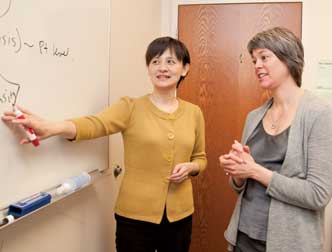 Amber Barnato (right) had a question: Are elderly patients more likely to survive their illnesses when they go to hospitals that use more intensive care and life-support? Barnato is a professor of medicine, clinical and translational science, and health policy and management with appointments in the School of Medicine and the Graduate School of Public Health, but she needed a statistician. She linked up with Chung-Chou H. Chang (left), a professor of biostatistics and medicine, who developed a new application of statistics for the study. Their research found some intriguing initial answers: there was a survival benefit with admission to a higher-intensity hospital. Consequently, the National Institute of Aging funded Barnato for a three-year, $500,000 R01 project to investigate further.
Amber Barnato (right) had a question: Are elderly patients more likely to survive their illnesses when they go to hospitals that use more intensive care and life-support? Barnato is a professor of medicine, clinical and translational science, and health policy and management with appointments in the School of Medicine and the Graduate School of Public Health, but she needed a statistician. She linked up with Chung-Chou H. Chang (left), a professor of biostatistics and medicine, who developed a new application of statistics for the study. Their research found some intriguing initial answers: there was a survival benefit with admission to a higher-intensity hospital. Consequently, the National Institute of Aging funded Barnato for a three-year, $500,000 R01 project to investigate further.Barnato, associate professor of medicine, clinical and translational science, and health policy and management with appointments in the School of Medicine and the Graduate School of Public Health, needed a statistician. Chung-Chou H. Chang, an associate professor of biostatistics and medicine, not only fit the bill, but she also developed a new application of statistics for the study. Together, they found some intriguing initial answers: there was a survival benefit with admission to a higher-intensity hospital. Consequently, the National Institute of Aging took notice, funding Barnato for a three-year, $500,000 R01 project to investigate further.
Case Study: A Hitchhiker’s Guide to the Brain
When MD/PhD student Amir Faraji was measuring properties of fluid transport in the brain, he wondered whether it would be possible to hijack some of these properties and deliver compounds into the brain—specifically, to convey chemotherapy agents to any nefarious cancer cells lingering in postsurgical margins.
The concept is so novel and the laboratory work so promising that Faraji, a fourth-year student, has filed one patent disclosure based on preliminary data, and he is working on a second.
“I’m driven by clinical problems,” says Faraji, whose ultimate goal is to unite his passions for neurosurgery, oncology, and chemistry into what he recognizes will be a demanding career as a physician-scientist. “Now we want to do proof of principle in vivo.”
University of Pittsburgh Cancer Institute
Some of the largest clinical trials of experimental cancer therapies are carried out by a national network of cancer centers and funded by the National Cancer Institute (NCI). Lots of cancer centers take part in these important trials, and the University of Pittsburgh Cancer Institute (UPCI) is no exception, notes Nancy Davidson, Hillman Professor of Oncology and director of UPCI, but she adds, “We pride ourselves in the kind of research that takes an idea out of our laboratories, does its initial testing in the clinic, and gets it to the point where it would go into one of these cooperative group trials.”
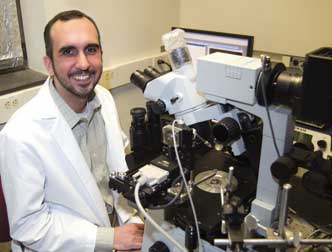 Pitt MD/PhD student Amir Faraji wants to find out whether it’s possible to send chemotherapy agents to attack lingering cancer cells in the brain that remain in the post-surgical margins after a tumor is removed. “I’m driven by clinical problems,” says Faraji, whose ultimate goal is to unite his passions for neurosurgery, oncology, and chemistry into what he recognizes will be a demanding career as a physician-scientist.
Pitt MD/PhD student Amir Faraji wants to find out whether it’s possible to send chemotherapy agents to attack lingering cancer cells in the brain that remain in the post-surgical margins after a tumor is removed. “I’m driven by clinical problems,” says Faraji, whose ultimate goal is to unite his passions for neurosurgery, oncology, and chemistry into what he recognizes will be a demanding career as a physician-scientist.There have been significant examples of exactly this type of translational cancer research in Pittsburgh, starting with one that predates UPCI itself. (Founded in 1985, UPCI became an NCI-designated Comprehensive Cancer Center in only five years.) In 1985, Bernard Fisher, a Pitt professor of surgery and 1943 graduate of the University of Pittsburgh School of Medicine, and a team of researchers demonstrated in clinical trials that lumpectomy combined with radiation therapy is as effective as radical mastectomy in treating breast cancer. The news that many women with breast cancer, who might otherwise undergo a disfiguring radical mastectomy, could opt for lumpectomy was a dramatic advance in the treatment of breast cancer. Fisher’s group would go on to show the effectiveness of chemotherapy and hormonal therapy (tamoxifen) in preventing recurrence.
Fisher’s work was a tour de force of translational medicine, particularly with respect to clinical trial design and execution. Like the best translational medicine, it began with a fundamental insight into cancer biology—that cancer was a systemic disease more often than a localized disease—made by Fisher in the surgical research laboratory that he founded at the University of Pittsburgh, then proceeded through rigorous clinical testing, and ended with improved clinical practices that led to better health for the public.
As UPCI celebrates its 25th anniversary, it looks back on extraordinary growth in its translational research program, with some of the most exciting and promising work in the area of cancer vaccines and immunotherapy. Most of us know vaccines as agents that turn the immune system against a foreign invader, such as a virus. But cancer isn’t a foreign invader. It’s your own cells gone bad. To teach the immune system to target cancer, scientists must first identify molecules that distinguish cancer cells from normal cells. The first clinical trial in the world of a synthetic peptide cancer vaccine—at Pitt in 1993—enrolled patients with very advanced cancer and poor prognoses. Regulators deemed the risk of a vaccine precipitating an immune attack against healthy tissue too great to include patients with better odds. “The first patient died of her advanced cancer within a month of us starting the trial, not even giving the vaccine time to generate an immune response” says Olivera Finn, Distinguished Professor and chair in the Department of Immunology and coleader of UPCI’s cancer immunology program.
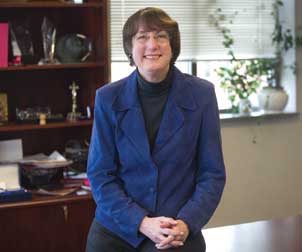 Some of the largest clinical trials of experimental cancer therapies are carried out by a national network of cancer centers and funded by the National Cancer Institute. Lots of cancer centers take part in these important trials, and the University of Pittsburgh Cancer Institute (UPCI) is no exception, notes Nancy Davidson, Hillman Professor of Oncology and director of UPCI, but she adds, “We pride ourselves on the kind of research that takes an idea out of our laboratories, does its initial testing in the clinic, and gets it to the point where it would go into one of these cooperative group trials.”
Some of the largest clinical trials of experimental cancer therapies are carried out by a national network of cancer centers and funded by the National Cancer Institute. Lots of cancer centers take part in these important trials, and the University of Pittsburgh Cancer Institute (UPCI) is no exception, notes Nancy Davidson, Hillman Professor of Oncology and director of UPCI, but she adds, “We pride ourselves on the kind of research that takes an idea out of our laboratories, does its initial testing in the clinic, and gets it to the point where it would go into one of these cooperative group trials.”A lot has happened since then, and cancer immunotherapy is now more realistically expected to prevent cancer, prevent recurrence, or cure cancer in its early stages. A new version of Finn’s 1993 vaccine is currently being tested in patients diagnosed with premalignant colonic adenomas, precursors to colon cancer, to prevent adenoma recurrence and progression to cancer. In another example, Theresa Whiteside, professor of pathology, otolaryngology, and immunology, along with professor of immunology Soldano Ferrone, has developed a vaccine able to target a unique molecule that appears on head and neck tumor cells, as well as on the normal cells building blood vessels to sustain it.
Pitt’s John Kirkwood, professor and vice chair for clinical research in the Department of Medicine, developed the first adjuvant therapy for patients recovering from melanoma, a disease with a high rate of recurrence. Kirkwood’s interferon therapy stimulates the immune system’s natural killer cells against melanoma. Kirkwood leads a large, multidisciplinary and multi-laboratory melanoma program at UPCI, funded by a prestigious Specialized Program of Research Excellence (SPORE) grant from NIH. Two other SPORE grants at UPCI support the lung cancer and the head and neck cancer programs.
Finn is currently working on laboratory experiments that define other cancer- promoting conditions that could be controlled with vaccines. People with chronic inflammatory disorders such as inflammatory bowel disease (IBD), for example, are at greater risk for developing cancer at the inflamed site, says Finn. Her group has reported that a vaccine directed against an abnormal variant of a self-made cell protein called MUC1, which is altered and produced in excess in both IBD and colon cancer, has the potential to delay the onset of IBD and, in turn, prevent progression to colon cancer. Their findings, reported in Cancer Prevention Research in 2010, suggest that early stages of chronic inflammation might be considered a premalignant condition.
The Evolution and Revolution of Translational Medicine
By creating an institutional culture that places a high value on translational medicine, the University of Pittsburgh strives to contribute to the future of medicine, whether those contributions are giant leaps forward or small steps along the path to better outcomes and better quality of life for patients.
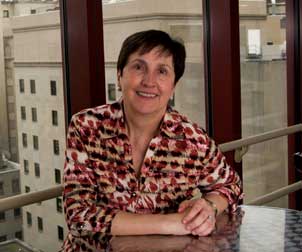 Some of UPCI’s most exciting and promising work during its 25 years of existence has been in the area of cancer vaccines and immunotherapy. Olivera Finn, Distinguished Professor and chair of the Department of Immunology and coleader of UPCI’s Cancer Immunology Program, for example, developed a synthetic peptide cancer vaccine that has been in clinical trials in patients with various cancers since 1993. The vaccine—which has shown promise in stabilizing disease and prolonging survival without toxicity—is currently being tested in patients diagnosed with premalignant colonic adenomas, precursors to colon cancer, to prevent adenoma recurrence and progression to cancer. Other trials are being planned for prevention of pancreatic and lung cancer.
Some of UPCI’s most exciting and promising work during its 25 years of existence has been in the area of cancer vaccines and immunotherapy. Olivera Finn, Distinguished Professor and chair of the Department of Immunology and coleader of UPCI’s Cancer Immunology Program, for example, developed a synthetic peptide cancer vaccine that has been in clinical trials in patients with various cancers since 1993. The vaccine—which has shown promise in stabilizing disease and prolonging survival without toxicity—is currently being tested in patients diagnosed with premalignant colonic adenomas, precursors to colon cancer, to prevent adenoma recurrence and progression to cancer. Other trials are being planned for prevention of pancreatic and lung cancer.One of those giant leaps forward—and a seminal moment in the University’s history—came in 1984, when Pitt professor of surgery Thomas E. Starzl performed the world’s first double transplant operation (simultaneous heart and liver transplantation) on a 6-year-old girl from Texas. In the early days of organ transplantation, no person worked harder than Starzl to develop new surgical techniques and advance experimental immunosuppressive drugs like cyclosporine—all of which were necessary to make these life-saving procedures available to deathly ill patients. Practically overnight, Pittsburgh became the organ transplantation capital of the world.
Dramatic and revolutionary events such as this may be rare, but they owe their provenance to the hard work that yields steady progress over long periods of time. The steady growth of the scientific and clinical enterprise in Pittsburgh over several decades has many observers wondering what dramatic new milestones are on the horizon.
“There has been an evolution—if not a revolution—in the way we conduct research at the University of Pittsburgh,” says Levine. “And my own sense is that this process is just beginning to hit its stride.”
Other Stories From This Issue
On the Freedom Road

Follow a group of Pitt students on the Returning to the Roots of Civil Rights bus tour, a nine-day, 2,300-mile journey crisscrossing five states.
Day 1: The Awakening
Day 2: Deep Impressions
Day 3: Music, Montgomery, and More
Day 4: Looking Back, Looking Forward
Day 5: Learning to Remember
Day 6: The Mountaintop
Day 7: Slavery and Beyond
Day 8: Lessons to Bring Home
Day 9: Final Lessons

